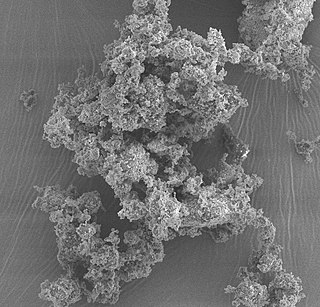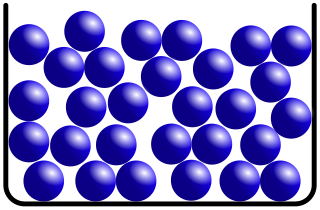
Melting, or fusion, is a physical process that results in the phase transition of a substance from a solid to a liquid. This occurs when the internal energy of the solid increases, typically by the application of heat or pressure, which increases the substance's temperature to the melting point. At the melting point, the ordering of ions or molecules in the solid breaks down to a less ordered state, and the solid melts to become a liquid.

An amorphous metal is a solid metallic material, usually an alloy, with disordered atomic-scale structure. Most metals are crystalline in their solid state, which means they have a highly ordered arrangement of atoms. Amorphous metals are non-crystalline, and have a glass-like structure. But unlike common glasses, such as window glass, which are typically electrical insulators, amorphous metals have good electrical conductivity and can show metallic luster.

Arsenic trisulfide is the inorganic compound with the formula As2S3. It is a dark yellow solid that is insoluble in water. It also occurs as the mineral orpiment, which has been used as a pigment called King's yellow. It is produced in the analysis of arsenic compounds. It is a group V/VI, intrinsic p-type semiconductor and exhibits photo-induced phase-change properties.

Lead(II) chloride (PbCl2) is an inorganic compound which is a white solid under ambient conditions. It is poorly soluble in water. Lead(II) chloride is one of the most important lead-based reagents. It also occurs naturally in the form of the mineral cotunnite.
Chalcogenide glass is a glass containing one or more chalcogens. Polonium is also a chalcogen but is not used because of its strong radioactivity. Chalcogenide materials behave rather differently from oxides, in particular their lower band gaps contribute to very dissimilar optical and electrical properties.
In chemistry, an aluminate is a compound containing an oxyanion of aluminium, such as sodium aluminate. In the naming of inorganic compounds, it is a suffix that indicates a polyatomic anion with a central aluminium atom.

Bioactive glasses are a group of surface reactive glass-ceramic biomaterials and include the original bioactive glass, Bioglass. The biocompatibility and bioactivity of these glasses has led them to be used as implant devices in the human body to repair and replace diseased or damaged bones. Most bioactive glasses are silicate-based glasses that are degradable in body fluids and can act as a vehicle for delivering ions beneficial for healing. Bioactive glass is differentiated from other synthetic bone grafting biomaterials, in that it is the only one with anti-infective and angiogenic properties.

Bismuth(III) oxide is a compound of bismuth, and a common starting point for bismuth chemistry. It is found naturally as the mineral bismite (monoclinic) and sphaerobismoite, but it is usually obtained as a by-product of the smelting of copper and lead ores. Dibismuth trioxide is commonly used to produce the "Dragon's eggs" effect in fireworks, as a replacement of red lead.

Lanthanum(III) oxide, also known as lanthana, chemical formula La2O3, is an inorganic compound containing the rare earth element lanthanum and oxygen. It is used in some ferroelectric materials, as a component of optical materials, and is a feedstock for certain catalysts, among other uses.
Phosphate glass is a class of optical glasses composed of metaphosphates of various metals. Instead of SiO2 in silicate glasses, the glass forming substrate is P2O5.

Fluoride glass is a class of non-oxide optical glasses composed of fluorides of various metals. They can contain heavy metals such as zirconium, or be combined with lighter elements like aluminium and beryllium. These heavier elements cause the glass to have a transparency range extended into the infrared wavelength.

In chemistry, germanate is a compound containing an oxyanion of germanium. In the naming of inorganic compounds it is a suffix that indicates a polyatomic anion with a central germanium atom, for example potassium hexafluorogermanate, K2GeF6.

Sodium bismuthate is an inorganic compound, and a strong oxidiser with chemical formula NaBiO3. It is somewhat hygroscopic, but not soluble in cold water, which can be convenient since the reagent can be easily removed after the reaction. It is one of the few water insoluble sodium salts. Commercial samples may be a mixture of bismuth(V) oxide, sodium carbonate and sodium peroxide.

The structure of liquids, glasses and other non-crystalline solids is characterized by the absence of long-range order which defines crystalline materials. Liquids and amorphous solids do, however, possess a rich and varied array of short to medium range order, which originates from chemical bonding and related interactions. Metallic glasses, for example, are typically well described by the dense random packing of hard spheres, whereas covalent systems, such as silicate glasses, have sparsely packed, strongly bound, tetrahedral network structures. These very different structures result in materials with very different physical properties and applications.

Bismuth vanadate is the inorganic compound with the formula BiVO4. It is a bright yellow solid. It is widely studied as visible light photo-catalyst with a narrow band gap of less than 2.4 eV. It is a representative of "complex inorganic colored pigments," or CICPs. More specifically, bismuth vanadate is a mixed-metal oxide. Bismuth vanadate is also known under the Colour Index International as C.I. Pigment Yellow 184. It occurs naturally as the rare minerals pucherite, clinobisvanite, and dreyerite.
Gallium lanthanum sulfide glass is the name of a family of chalcogenide glasses, referred to as gallium lanthanum sulfide (Ga-La-S) glasses. They are mixtures of La2S3, La2O3, and Ga2S3, which form the basic glass with other glass modifiers added as needed. Gallium-lanthanum-sulfide glasses have a wide range of vitreous formation centered around a 70% Ga2S3 : 30% La2S3 mixture, and readily accept other modifier materials into their structure. This means that Ga-La-S composition can be adjusted to give a wide variety of optical and physical properties.

Bismuth oxynitrate is the name applied to a number of compounds that contain Bi3+, nitrate ions and oxide ions and which can be considered as compounds formed from Bi2O3, N2O5 and H2O. Other names for bismuth oxynitrate include bismuth subnitrate and bismuthyl nitrate. In older texts bismuth oxynitrate is often simply described as BiONO3 or basic bismuth nitrate. Bismuth oxynitrate was once called magisterium bismuti or bismutum subnitricum, and was used as a white pigment, in beauty care, and as a gentle disinfectant for internal and external use. It is also used to form Dragendorff's reagent, which is used as a TLC stain.
Rigidity theory, or topological constraint theory, is a tool for predicting properties of complex networks based on their composition. It was introduced by James Charles Phillips in 1979 and 1981, and refined by Michael Thorpe in 1983. Inspired by the study of the stability of mechanical trusses as pioneered by James Clerk Maxwell, and by the seminal work on glass structure done by William Houlder Zachariasen, this theory reduces complex molecular networks to nodes constrained by rods, thus filtering out microscopic details that ultimately don't affect macroscopic properties. An equivalent theory was developed by P.K. Gupta A.R. Cooper in 1990, where rather than nodes representing atoms, they represented unit polytopes. An example of this would be the SiO tetrahedra in pure glassy silica. This style of analysis has applications in biology and chemistry, such as understanding adaptability in protein-protein interaction networks. Rigidity theory applied to the molecular networks arising from phenotypical expression of certain diseases may provide insights regarding their structure and function.

Boron monofluoride monoxide or oxoboryl fluoride or fluoroxoborane is an unstable inorganic molecular substance with formula FBO. It is also called boron fluoride oxide, fluoro(oxo)borane or fluoro-oxoborane. The molecule is stable at high temperatures, but below 1000 °C condenses to a trimer (BOF)3 called trifluoroboroxin. FBO can be isolated as a triatomic non-metallic molecule in an inert gas matrix, and has been condensed in solid neon and argon. When an attempt is made to condense the gas to a solid in bulk, a polymeric glass is formed, which is deficient in fluoride, and when heated forms a glassy froth like popcorn. Boron fluoride oxide has been studied because of its production in high energy rocket fuels that contain boron and fluorine, and in the form of an oxyfluoride glass. BOF glass is unusual in that it can condense directly from gas.

Bismuth forms mainly trivalent and a few pentavalent compounds. Many of its chemical properties are similar to those of arsenic and antimony, although much less toxic.

![Lead bismuthate has a broad transmittance range in the IR spectra.7 When doped with Li2O to form Li2O-[Bi2O3-PbO], the transmittance can increase beyond 10-15 micrometers. The figure above shows the IR spectra of 30Li2O-35[Bi2O3-PbO] glass composition, which contains 30 mole percent Li2O. Lead bismuthate 1.jpg](http://upload.wikimedia.org/wikipedia/commons/thumb/0/03/Lead_bismuthate_1.jpg/220px-Lead_bismuthate_1.jpg)
![Infusing varying mole concentrations of Li2O within the structure of lead bismuthate to form Li2O-[Bi2O3-PbO] can increase the transmittance spectra of lead bismuthate glass within and beyond the visible range.7 The figure shows the UV-Vis spectra of lead bismuthate glass compositions with (a) 20, (b) 30, (c) 40, (d) 50 and (e) 60 mole percent of Li2O. Lead bismuthate 2.png](http://upload.wikimedia.org/wikipedia/commons/thumb/b/b5/Lead_bismuthate_2.png/220px-Lead_bismuthate_2.png)













